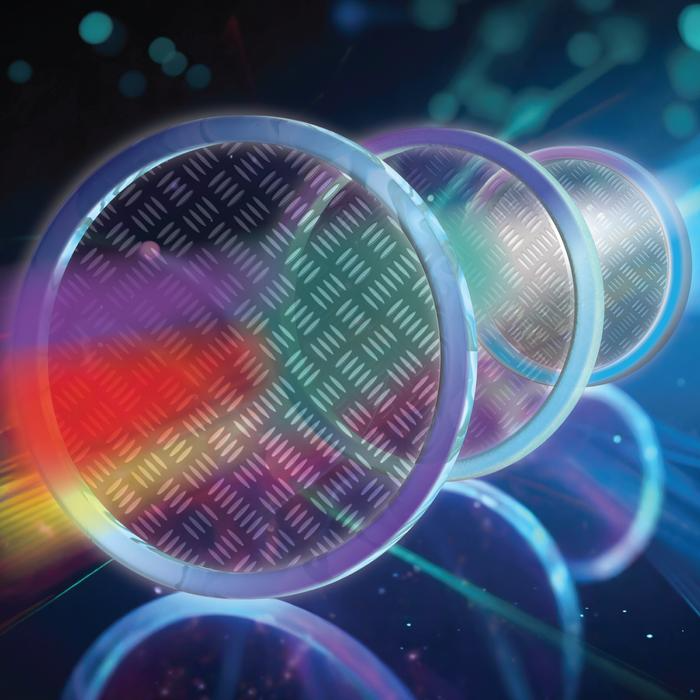A novel method has been created by researchers who do thermal imaging using meta-optical devices. The method offers more detailed information about the objects being scanned, which could give rise to a wider use of thermal imaging in domains including remote sensing, autonomous navigation, security, thermography, and medical imaging.

Researchers used a stack of spinning metasurface devices to capture spectral and polarization details of thermal radiation as well as the intensity information that is acquired with traditional thermal imaging. Image Credit: Xueji Wang, Purdue University
Our method overcomes the challenges of traditional spectral thermal imagers, which are often bulky and delicate due to their reliance on large filter wheels or interferometers. We combined meta-optical devices and cutting-edge computational imaging algorithms to create a system that is both compact and robust while also having a large field of view.
Zubin Jacob, Research Team Leader, Purdue University
Researchers present their innovative spectro-polarimetric decomposition system, which employs a stack of spinning metasurfaces to separate thermal light into its spectral and polarimetric components, in Optica, the high-impact academic journal published by Optica Publishing Group.
This enables the imaging system to record not only the intensity data obtained by conventional thermal imaging but also the spectrum and polarization features of thermal radiation.
The researchers demonstrated that the novel system can effectively categorize different materials using a commercial thermal camera; this is a task that is often difficult for traditional thermal cameras. Temperature fluctuations may be distinguished using the approach, and materials can be identified using spectro-polarimetric signatures.
These capabilities potentially improve safety and efficiency for a range of applications, including autonomous navigation.
Traditional autonomous navigation approaches rely heavily on RGB cameras, which struggle in challenging conditions like low light or bad weather. When integrated with heat-assisted detection and ranging technology, our spectro-polarimetric thermal camera can provide vital information in these difficult scenarios, offering clearer images than RGB or conventional thermal cameras. Once we achieve real-time video capture, the technology could significantly enhance scene perception and overall safety.
Xueji Wang, Study First Author and Postdoctoral Researcher, Purdue University
Doing More with a Smaller Imager
Long-wave infrared spectro-polarimetric imaging is essential for applications including thermography, machine vision, night vision, and trace gas sensing. Nevertheless, the spectro-polarimetric long-wave infrared imagers of today are large, have a narrow field of view, and have poor spectral resolution.
The researchers used large-area metasurfaces, which are incredibly thin structured surfaces with sophisticated light manipulation capabilities, to get around these constraints. They devised a manufacturing technique that enabled the use of spinning dispersive metasurfaces with customized infrared responses to produce large-area (2.5-cm diameter) spinning devices appropriate for imaging applications. The resultant rotating stack is compatible with a conventional infrared camera and has dimensions of less than 10×10 ×10 cm.
Wang added, “Integrating these large-area meta-optical devices with computational imaging algorithms facilitated the efficient reconstruction of the thermal radiation spectrum. This enabled a more compact, robust and effective spectro-polarimetric thermal imaging system than was previously achievable.”
Classifying Materials with Thermal Imaging
The researchers used a variety of materials and microstructures, each with distinct spectro-polarimetric qualities, to spell out “Purdue” to assess their innovative technology. With the technique, they were able to get spectro-polarimetric data that allowed them to precisely discern between the various materials and objects.
They also showed that the system is three times more accurate in classifying materials than conventional thermal imaging techniques, which emphasizes its efficacy and adaptability.
The novel technique, according to the researchers, could prove extremely beneficial for applications requiring precise thermal imaging.
“In security, for example, it could revolutionize airport systems by detecting concealed items or substances on people. Moreover, its compact and robust design enhances its suitability for diverse environmental conditions, making it particularly beneficial for applications such as autonomous navigation,” Wang further stated.
The researchers are attempting to improve the technique’s spectral resolution, transmission efficiency, and speed of image collection and processing in addition to trying to capture video using the device. To achieve higher spectral resolution and more complicated light manipulation, they also intend to enhance the metasurface design.
Furthermore, as the technique was limited to high-temperature objects by the use of metasurface stacks, they wish to expand it to room-temperature imaging. They want to do this through the use of enhanced materials, metasurface designs, and methods such as anti-reflection coatings.
Journal Reference:
Wang, X., et. al. (2023) Spinning metasurface stack for spectro-polarimetric thermal imaging. Optica. doi:10.1364/OPTICA.506813
Source: https://www.optica.org/